Abstract
1. Suppression of voluntary muscle activity of hand and arm muscles in response to transcranial magnetic stimulation (TMS) of the motor cortex has been investigated in man. 2. Suppression could be elicited by low levels of TMS without any prior excitatory response. The latency of the suppression was 3-8 ms longer than the excitation observed at a higher stimulus intensity. The duration of the suppression ranged from 8 to 26 ms. 3. A circular stimulating coil was used to determine threshold intensity for excitation and suppression of contraction of thenar muscles in response to TMS at different locations over the motor cortex. The locations for lowest threshold excitation coincided with those for lowest threshold suppression. Suppression was elicited at a lower threshold than excitation at all locations. 4. A figure-of-eight stimulating coil was positioned over the left motor cortex at the lowest threshold point for excitation of the right thenar muscles. The orientation for the lowest threshold excitatory and inhibitory responses was the same for all subjects. That orientation induced a stimulating current travelling in an antero-medial direction. Suppression was invariably elicited at lower thresholds than excitation. 5. When antagonistic muscles (second and third dorsal interosseus) were co-contracted, TMS evoked coincident suppression of voluntary EMG in the two muscles without prior excitation of either muscle. This suggests that the suppression is not mediated via corticospinal activation of spinal interneurones. 6. Test responses to electrical stimulation of the cervical spinal cord were evoked in both relaxed and activated thenar muscles. In the relaxed muscle, prior TMS at an intensity that would suppress voluntary activity failed to influence the test responses, suggesting absence of inhibition at a spinal level. However, in the activated muscle, prior TMS could reduce the test response. This may be explained by disfacilitation of motoneurones due to inhibition of corticospinal output. 7. We propose that suppression of voluntary muscle activity by TMS is due in large part to activation of a mechanism within the motor cortex that reduces the corticospinal output to the muscle. It is concluded that TMS evokes excitation and inhibition via neuronal structures lying close to one another and having similar orientations.
Full text
PDF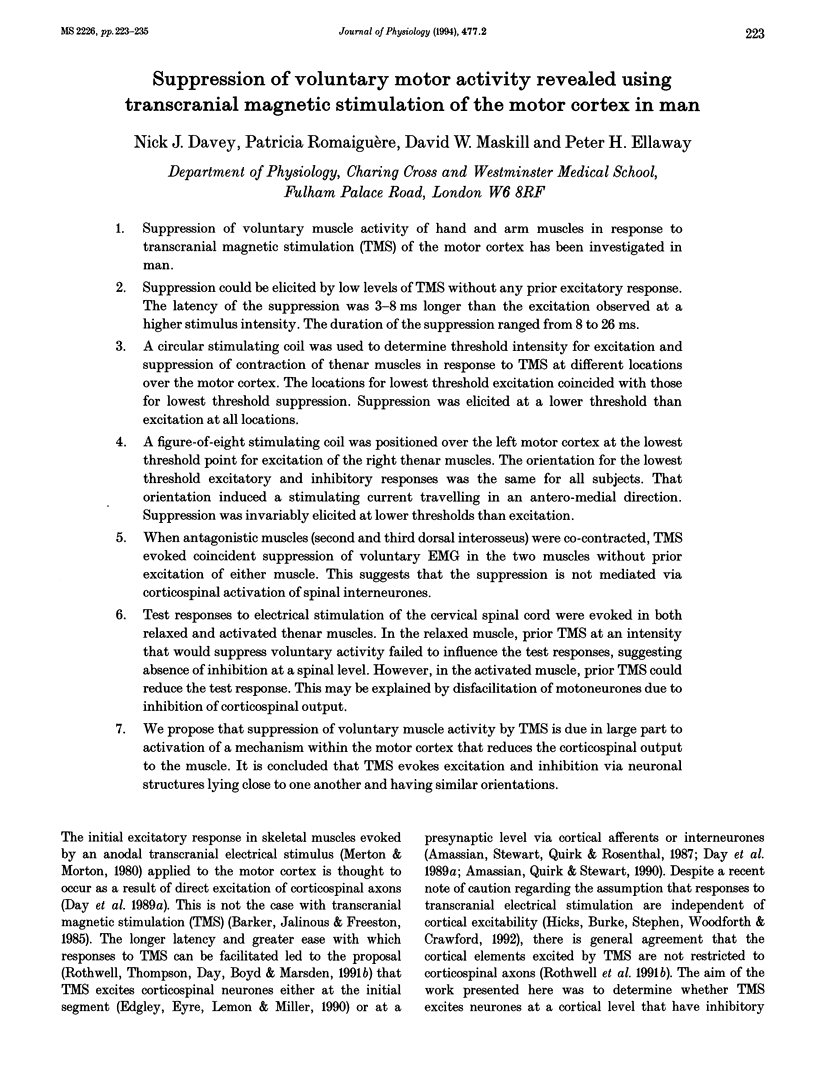
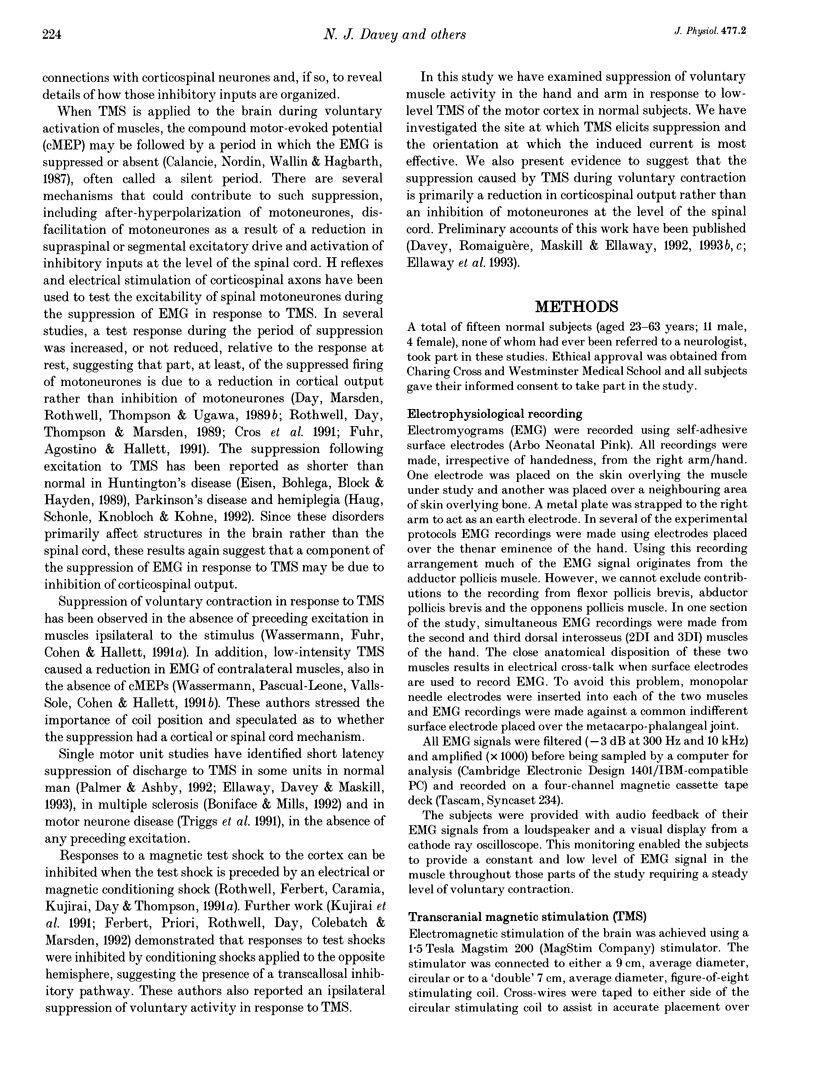
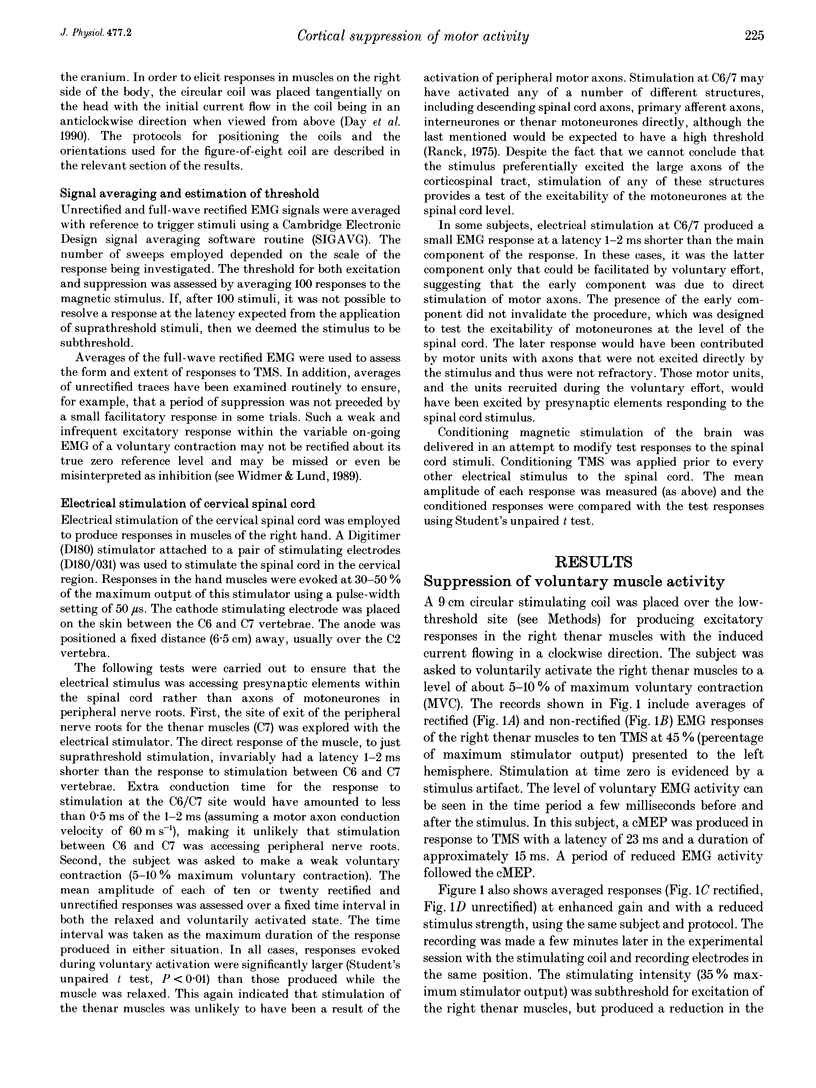
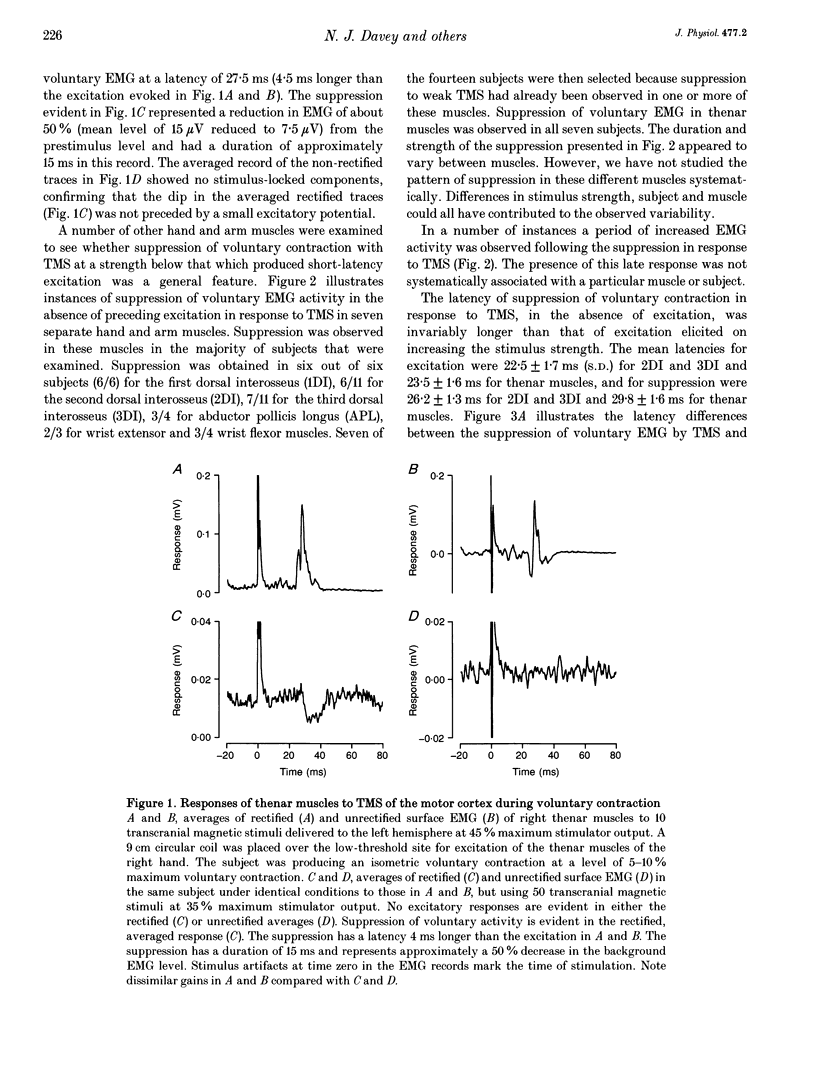
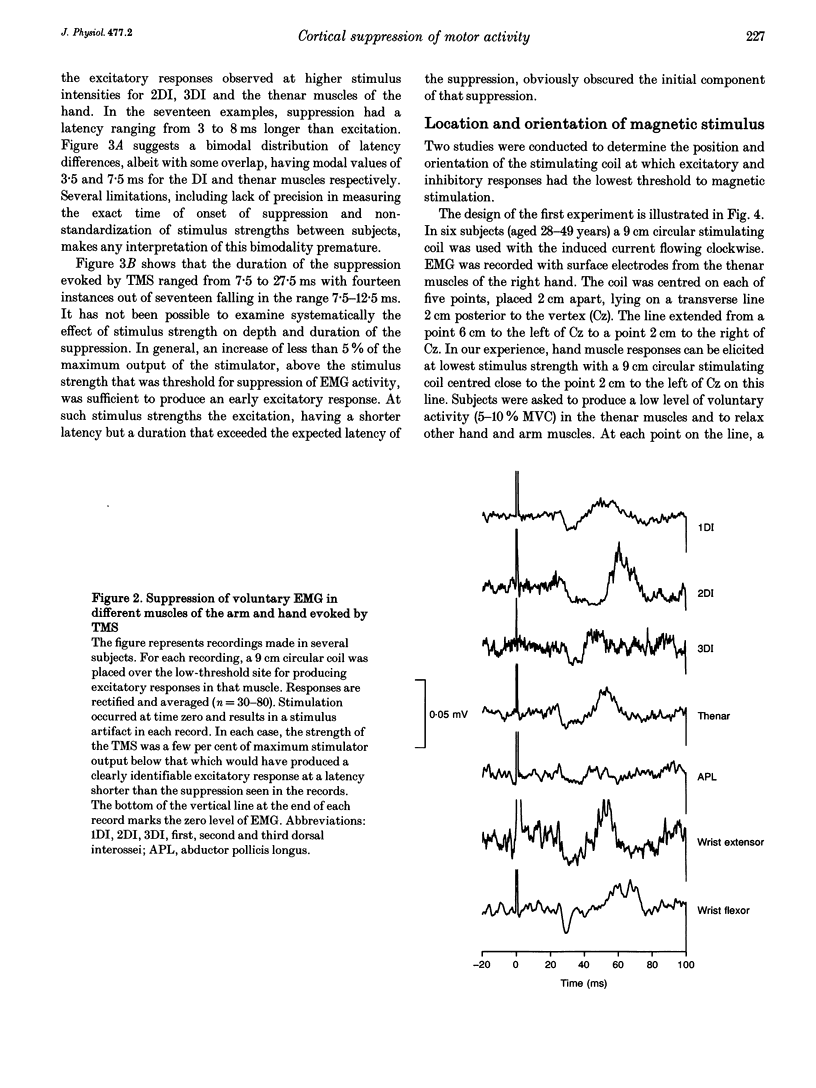
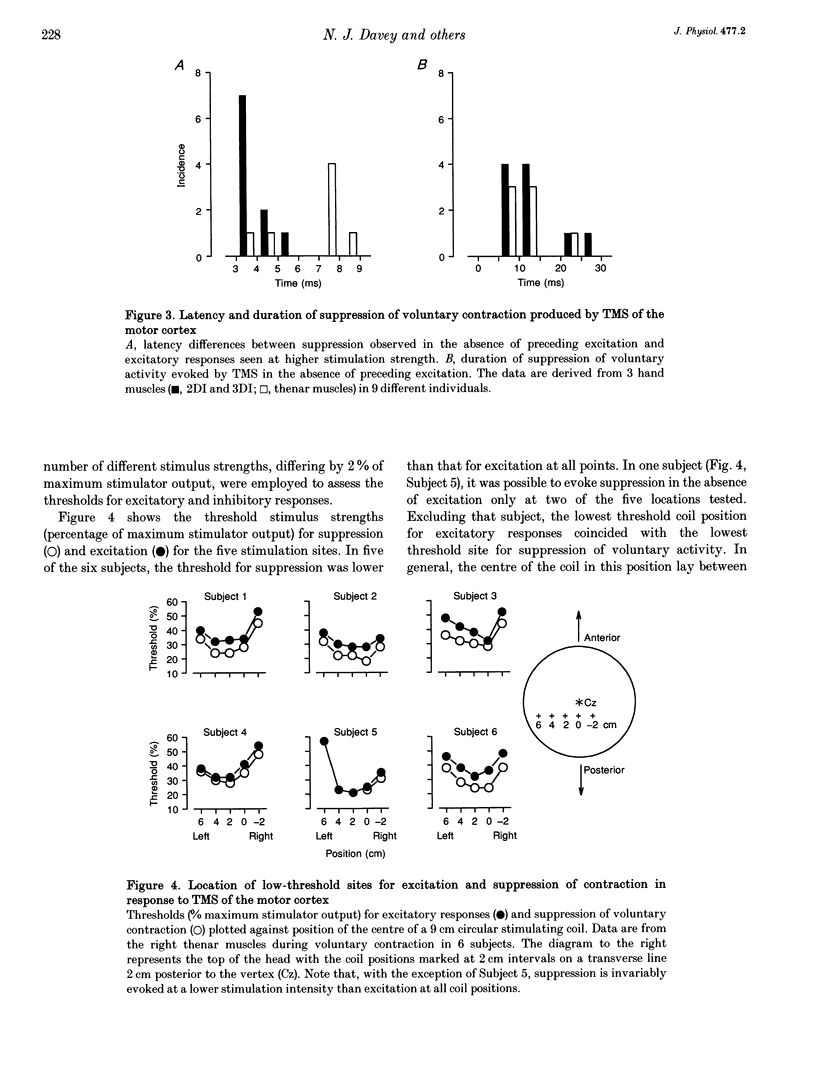
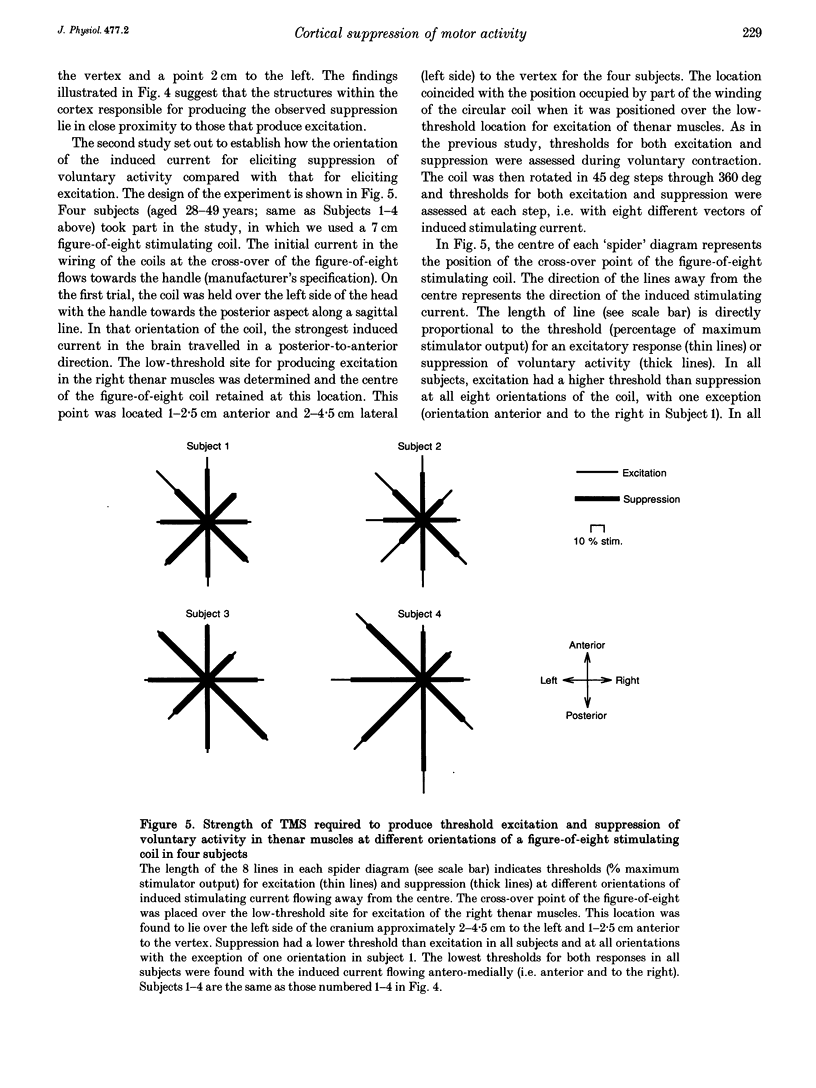
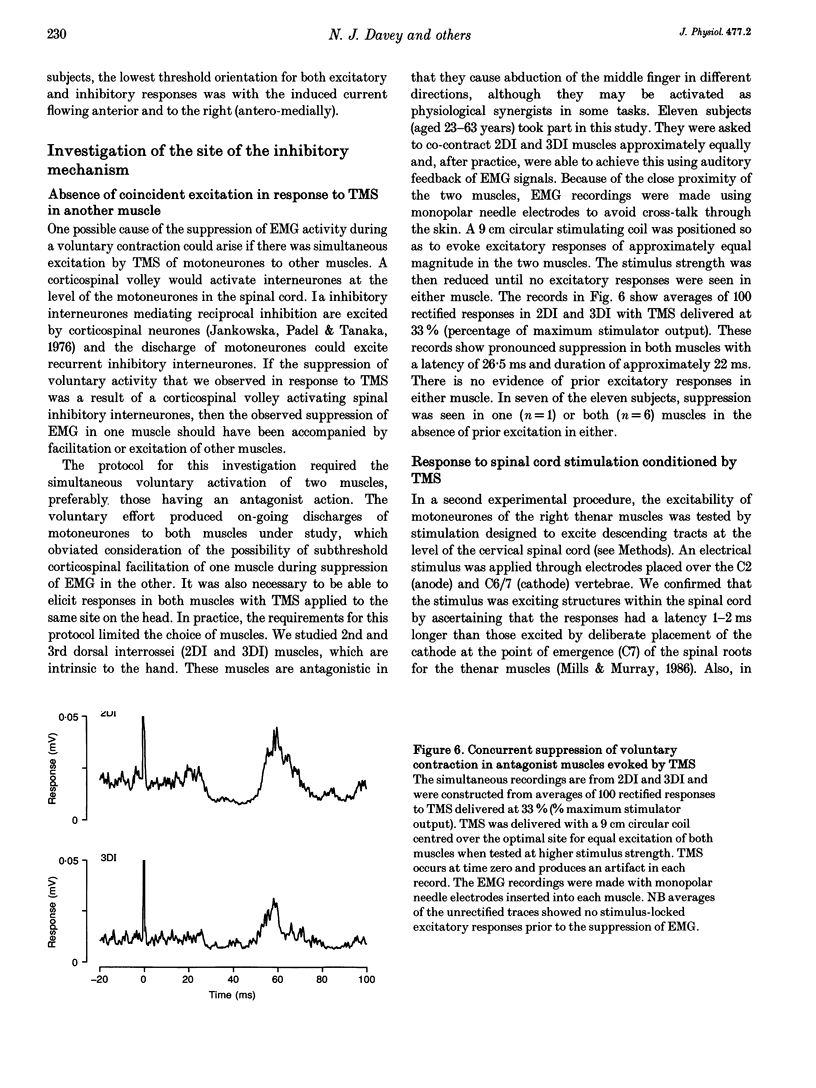

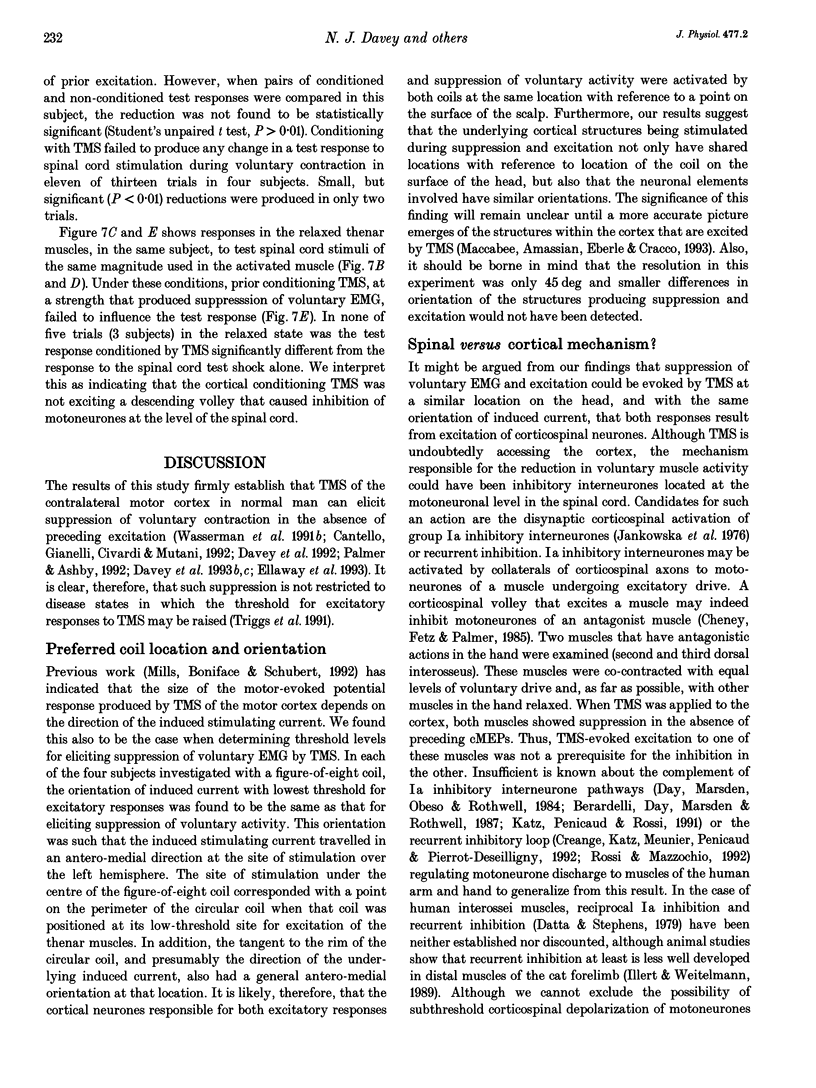
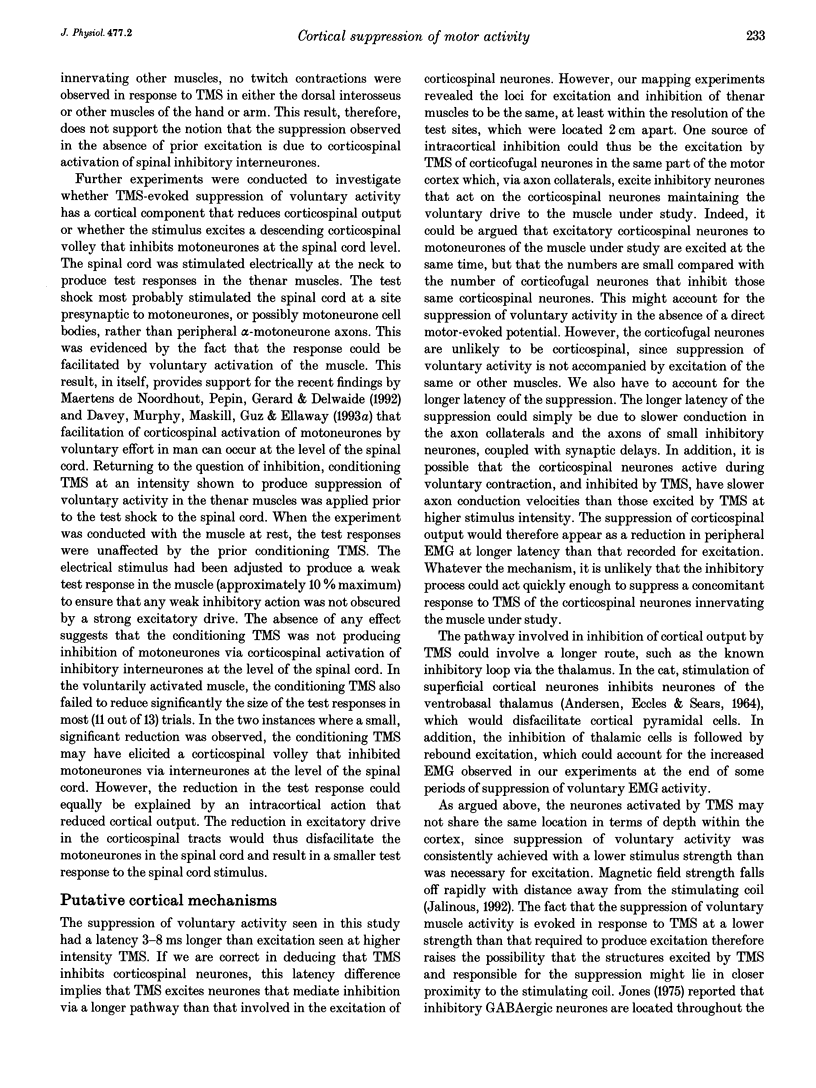

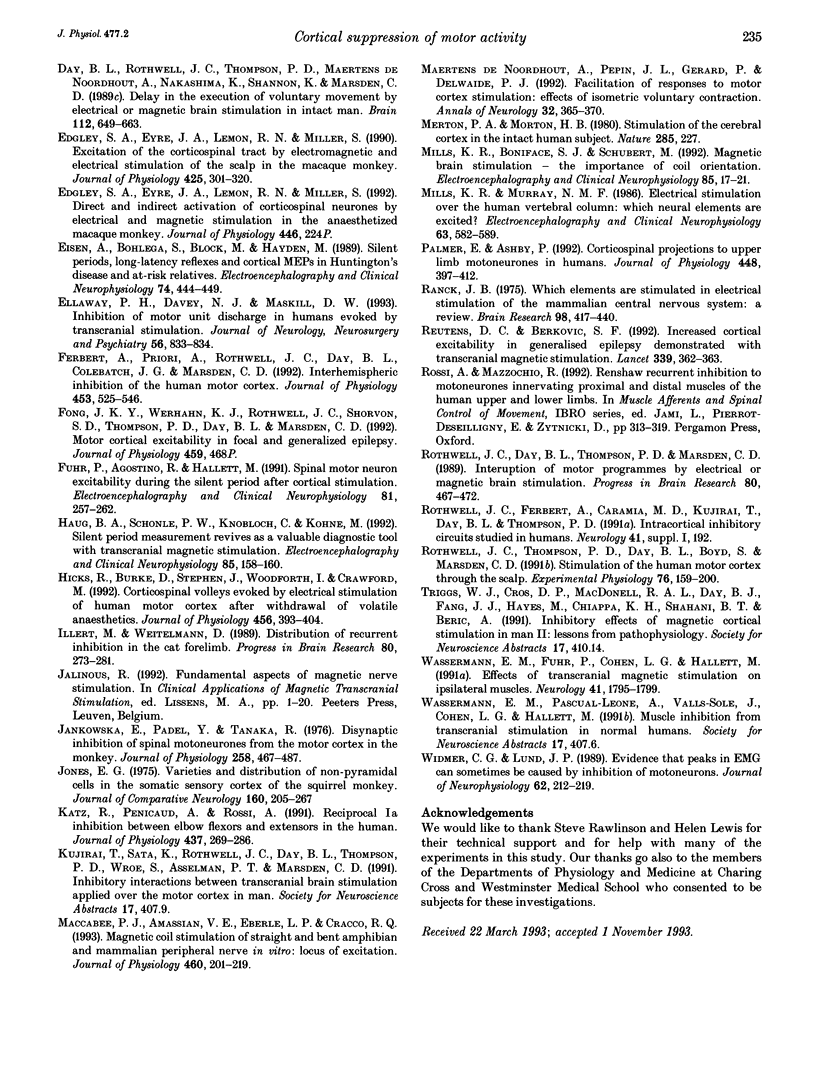
Selected References
These references are in PubMed. This may not be the complete list of references from this article.
- ANDERSEN P., ECCLES J. C., SEARS T. A. THE VENTRO-BASAL COMPLEX OF THE THALAMUS: TYPES OF CELLS, THEIR RESPONSES AND THEIR FUNCTIONAL ORGANIZATION. J Physiol. 1964 Nov;174:370–399. doi: 10.1113/jphysiol.1964.sp007493. [DOI] [PMC free article] [PubMed] [Google Scholar]
- Amassian V. E., Quirk G. J., Stewart M. A comparison of corticospinal activation by magnetic coil and electrical stimulation of monkey motor cortex. Electroencephalogr Clin Neurophysiol. 1990 Sep-Oct;77(5):390–401. doi: 10.1016/0168-5597(90)90061-h. [DOI] [PubMed] [Google Scholar]
- Amassian V. E., Stewart M., Quirk G. J., Rosenthal J. L. Physiological basis of motor effects of a transient stimulus to cerebral cortex. Neurosurgery. 1987 Jan;20(1):74–93. [PubMed] [Google Scholar]
- Barker A. T., Jalinous R., Freeston I. L. Non-invasive magnetic stimulation of human motor cortex. Lancet. 1985 May 11;1(8437):1106–1107. doi: 10.1016/s0140-6736(85)92413-4. [DOI] [PubMed] [Google Scholar]
- Berardelli A., Day B. L., Marsden C. D., Rothwell J. C. Evidence favouring presynaptic inhibition between antagonist muscle afferents in the human forearm. J Physiol. 1987 Oct;391:71–83. doi: 10.1113/jphysiol.1987.sp016726. [DOI] [PMC free article] [PubMed] [Google Scholar]
- Boniface S. J., Mills K. R. Suppression of motor neuron firing by transcranial magnetic stimulation in a patient with multiple sclerosis. J Neurol Neurosurg Psychiatry. 1992 Aug;55(8):738–739. doi: 10.1136/jnnp.55.8.738-a. [DOI] [PMC free article] [PubMed] [Google Scholar]
- Calancie B., Nordin M., Wallin U., Hagbarth K. E. Motor-unit responses in human wrist flexor and extensor muscles to transcranial cortical stimuli. J Neurophysiol. 1987 Nov;58(5):1168–1185. doi: 10.1152/jn.1987.58.5.1168. [DOI] [PubMed] [Google Scholar]
- Cantello R., Gianelli M., Civardi C., Mutani R. Magnetic brain stimulation: the silent period after the motor evoked potential. Neurology. 1992 Oct;42(10):1951–1959. doi: 10.1212/wnl.42.10.1951. [DOI] [PubMed] [Google Scholar]
- Cheney P. D., Fetz E. E., Palmer S. S. Patterns of facilitation and suppression of antagonist forelimb muscles from motor cortex sites in the awake monkey. J Neurophysiol. 1985 Mar;53(3):805–820. doi: 10.1152/jn.1985.53.3.805. [DOI] [PubMed] [Google Scholar]
- Datta A. K., Stephens J. A. The stimulus locked interval histogram: a method that may allow investigation of Renshaw inhibition in man [proceedings]. J Physiol. 1979 Aug;293:16P–17P. [PubMed] [Google Scholar]
- Day B. L., Dressler D., Maertens de Noordhout A., Marsden C. D., Nakashima K., Rothwell J. C., Thompson P. D. Electric and magnetic stimulation of human motor cortex: surface EMG and single motor unit responses. J Physiol. 1989 May;412:449–473. doi: 10.1113/jphysiol.1989.sp017626. [DOI] [PMC free article] [PubMed] [Google Scholar]
- Day B. L., Marsden C. D., Obeso J. A., Rothwell J. C. Reciprocal inhibition between the muscles of the human forearm. J Physiol. 1984 Apr;349:519–534. doi: 10.1113/jphysiol.1984.sp015171. [DOI] [PMC free article] [PubMed] [Google Scholar]
- Day B. L., Rothwell J. C., Thompson P. D., Maertens de Noordhout A., Nakashima K., Shannon K., Marsden C. D. Delay in the execution of voluntary movement by electrical or magnetic brain stimulation in intact man. Evidence for the storage of motor programs in the brain. Brain. 1989 Jun;112(Pt 3):649–663. doi: 10.1093/brain/112.3.649. [DOI] [PubMed] [Google Scholar]
- Edgley S. A., Eyre J. A., Lemon R. N., Miller S. Excitation of the corticospinal tract by electromagnetic and electrical stimulation of the scalp in the macaque monkey. J Physiol. 1990 Jun;425:301–320. doi: 10.1113/jphysiol.1990.sp018104. [DOI] [PMC free article] [PubMed] [Google Scholar]
- Eisen A., Bohlega S., Bloch M., Hayden M. Silent periods, long-latency reflexes and cortical MEPs in Huntington's disease and at-risk relatives. Electroencephalogr Clin Neurophysiol. 1989 Nov-Dec;74(6):444–449. doi: 10.1016/0168-5597(89)90034-8. [DOI] [PubMed] [Google Scholar]
- Ellaway P. H., Davey N. J., Maskill D. W. Inhibition of motor unit discharge in humans evoked by transcranial magnetic stimulation. J Neurol Neurosurg Psychiatry. 1993 Jul;56(7):833–834. doi: 10.1136/jnnp.56.7.833-a. [DOI] [PMC free article] [PubMed] [Google Scholar]
- Ferbert A., Priori A., Rothwell J. C., Day B. L., Colebatch J. G., Marsden C. D. Interhemispheric inhibition of the human motor cortex. J Physiol. 1992;453:525–546. doi: 10.1113/jphysiol.1992.sp019243. [DOI] [PMC free article] [PubMed] [Google Scholar]
- Fuhr P., Agostino R., Hallett M. Spinal motor neuron excitability during the silent period after cortical stimulation. Electroencephalogr Clin Neurophysiol. 1991 Aug;81(4):257–262. doi: 10.1016/0168-5597(91)90011-l. [DOI] [PubMed] [Google Scholar]
- Haug B. A., Schönle P. W., Knobloch C., Köhne M. Silent period measurement revives as a valuable diagnostic tool with transcranial magnetic stimulation. Electroencephalogr Clin Neurophysiol. 1992 Apr;85(2):158–160. doi: 10.1016/0168-5597(92)90081-l. [DOI] [PubMed] [Google Scholar]
- Hicks R., Burke D., Stephen J., Woodforth I., Crawford M. Corticospinal volleys evoked by electrical stimulation of human motor cortex after withdrawal of volatile anaesthetics. J Physiol. 1992 Oct;456:393–404. doi: 10.1113/jphysiol.1992.sp019342. [DOI] [PMC free article] [PubMed] [Google Scholar]
- Illert M., Wietelmann D. Distribution of recurrent inhibition in the cat forelimb. Prog Brain Res. 1989;80:273–271. doi: 10.1016/s0079-6123(08)62221-9. [DOI] [PubMed] [Google Scholar]
- Jankowska E., Padel Y., Tanaka R. Disynaptic inhibition of spinal motoneurones from the motor cortex in the monkey. J Physiol. 1976 Jun;258(2):467–487. doi: 10.1113/jphysiol.1976.sp011431. [DOI] [PMC free article] [PubMed] [Google Scholar]
- Katz R., Penicaud A., Rossi A. Reciprocal Ia inhibition between elbow flexors and extensors in the human. J Physiol. 1991 Jun;437:269–286. doi: 10.1113/jphysiol.1991.sp018595. [DOI] [PMC free article] [PubMed] [Google Scholar]
- Maccabee P. J., Amassian V. E., Eberle L. P., Cracco R. Q. Magnetic coil stimulation of straight and bent amphibian and mammalian peripheral nerve in vitro: locus of excitation. J Physiol. 1993 Jan;460:201–219. doi: 10.1113/jphysiol.1993.sp019467. [DOI] [PMC free article] [PubMed] [Google Scholar]
- Maertens de Noordhout A., Pepin J. L., Gerard P., Delwaide P. J. Facilitation of responses to motor cortex stimulation: effects of isometric voluntary contraction. Ann Neurol. 1992 Sep;32(3):365–370. doi: 10.1002/ana.410320310. [DOI] [PubMed] [Google Scholar]
- Merton P. A., Morton H. B. Stimulation of the cerebral cortex in the intact human subject. Nature. 1980 May 22;285(5762):227–227. doi: 10.1038/285227a0. [DOI] [PubMed] [Google Scholar]
- Mills K. R., Boniface S. J., Schubert M. Magnetic brain stimulation with a double coil: the importance of coil orientation. Electroencephalogr Clin Neurophysiol. 1992 Feb;85(1):17–21. doi: 10.1016/0168-5597(92)90096-t. [DOI] [PubMed] [Google Scholar]
- Mills K. R., Murray N. M. Electrical stimulation over the human vertebral column: which neural elements are excited? Electroencephalogr Clin Neurophysiol. 1986 Jun;63(6):582–589. doi: 10.1016/0013-4694(86)90145-8. [DOI] [PubMed] [Google Scholar]
- Palmer E., Ashby P. Corticospinal projections to upper limb motoneurones in humans. J Physiol. 1992 Mar;448:397–412. doi: 10.1113/jphysiol.1992.sp019048. [DOI] [PMC free article] [PubMed] [Google Scholar]
- Ranck J. B., Jr Which elements are excited in electrical stimulation of mammalian central nervous system: a review. Brain Res. 1975 Nov 21;98(3):417–440. doi: 10.1016/0006-8993(75)90364-9. [DOI] [PubMed] [Google Scholar]
- Reutens D. C., Berkovic S. F. Increased cortical excitability in generalised epilepsy demonstrated with transcranial magnetic stimulation. Lancet. 1992 Feb 8;339(8789):362–363. doi: 10.1016/0140-6736(92)91679-3. [DOI] [PubMed] [Google Scholar]
- Rothwell J. C., Day B. L., Thompson P. D., Marsden C. D. Interruption of motor programmes by electrical or magnetic brain stimulation in man. Prog Brain Res. 1989;80:467–466. doi: 10.1016/s0079-6123(08)62244-x. [DOI] [PubMed] [Google Scholar]
- Rothwell J. C., Thompson P. D., Day B. L., Boyd S., Marsden C. D. Stimulation of the human motor cortex through the scalp. Exp Physiol. 1991 Mar;76(2):159–200. doi: 10.1113/expphysiol.1991.sp003485. [DOI] [PubMed] [Google Scholar]
- Wassermann E. M., Fuhr P., Cohen L. G., Hallett M. Effects of transcranial magnetic stimulation on ipsilateral muscles. Neurology. 1991 Nov;41(11):1795–1799. doi: 10.1212/wnl.41.11.1795. [DOI] [PubMed] [Google Scholar]
- Widmer C. G., Lund J. P. Evidence that peaks in EMG averages can sometimes be caused by inhibition of motoneurons. J Neurophysiol. 1989 Jul;62(1):212–219. doi: 10.1152/jn.1989.62.1.212. [DOI] [PubMed] [Google Scholar]


